Light, medium, and heavy are all terms that guitarists use to describe the relative thickness of a set of guitar strings. Light strings are the thinnest, followed by medium, then heavy.
They’re really useful for quickly understanding what to expect from a set of guitar strings. But, if you’re just getting started with guitar, you might not know the differences between them!
Over my 20-something years of playing guitar, I’ve gone through plenty of light, medium, and heavy sets of guitar strings. So, I’ve created this guide that clearly explains the differences between each type, and my personal experiences with them.
To help me, I bought a set of each type of string and swapped them out on my guitar. I even made it into a video on my YouTube channel!
If you’re just looking for a quick summary, I’ve put a simple table below. But, I recommend checking out the whole article for important details.
| Light guitar strings | Medium guitar strings | Heavy guitar strings | |
|---|---|---|---|
| Gauge (electric guitar) | 9 and under | Between 10 and 11 | 12 and over |
| Gauge (acoustic guitar) | 12 and under | 13 | 14 and over |
| Gauge (bass guitar) | 45 and under | Between 50 and 60 | 65 and over |
| Sound | Bright | Warm | Dark |
| Feel | Very easy to use | Easy to use | Difficult to use |
| Durability | Low durability | Durable | High durability |
| Best for | Beginners and lead guitar | Good all-rounder | Drop drop tuning and rhythm guitar |
Affiliate disclaimer: This page contains affiliate links for products that I’ve tried and tested. As an Amazon Associate I earn from qualifying purchases at no additional cost to you. Learn more here.
What are light, medium, and heavy guitar strings?
The terms light, medium, and heavy describe the relative thickness of a set of guitar strings. Light strings are thinner compared to medium strings, which are thinner than heavy strings.
The thickness of your guitar strings (known properly as string gauge) has a big impact on their overall sound, feel, and usability. So, knowing whether a set of guitar strings is light, medium, or heavy gives guitar players a quick way to know what to expect.
Whether a set of strings is called light, medium, or heavy varies a little from company-to-company and person-to-person. So one company’s light might be another’s medium.
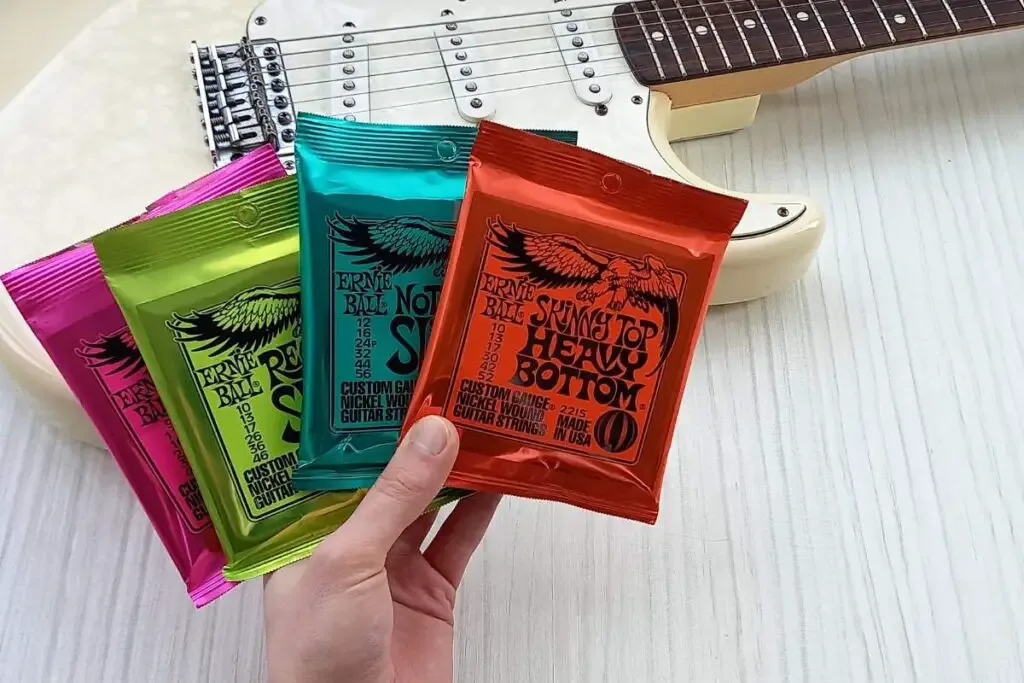
But, in my experience, there are some loosely agreed upon ranges for each type (at least, as much as the guitar community can agree on anything!). Though, it’s worth noting that ranges for light, medium, and heavy are very different across electric, acoustic, and bass guitars!
So, I made the below table to clearly show what makes a set of guitar strings either light, medium, or heavy. It’s worth remembering that sets of strings are most often referred to by their thinnest string – the first string!
| Light strings (gauge of 1st string) | Medium strings (gauge of 1st string) | Heavy strings (gauge of 1st string) | |
|---|---|---|---|
| Electric guitar | 9 and under | Between 10 and 11 | 12 and over |
| Acoustic guitar | 12 and under | 13 | 14 and over |
| Bass guitar (4 string) | 45 and under | Between 50 and 60 | 65 and over |
Light guitar strings
If you want your guitar strings to be easy to bend, gentle on your hand, and have a bright, snappy sound, then light gauge strings might be for you.
Most electric guitarists, myself included, consider light gauge strings to be any set with a first string that’s gauge 9 and under. For acoustic, light strings are considered anything under a 12.
Because they’re thinner, light gauge strings have a lower string tension compared to medium and heavy strings. So, it takes much less effort to bend or fret notes. (Of course, your guitar’s scale length and tuning also plays a key role in this – but I’m talking about a like-for-like comparison.)
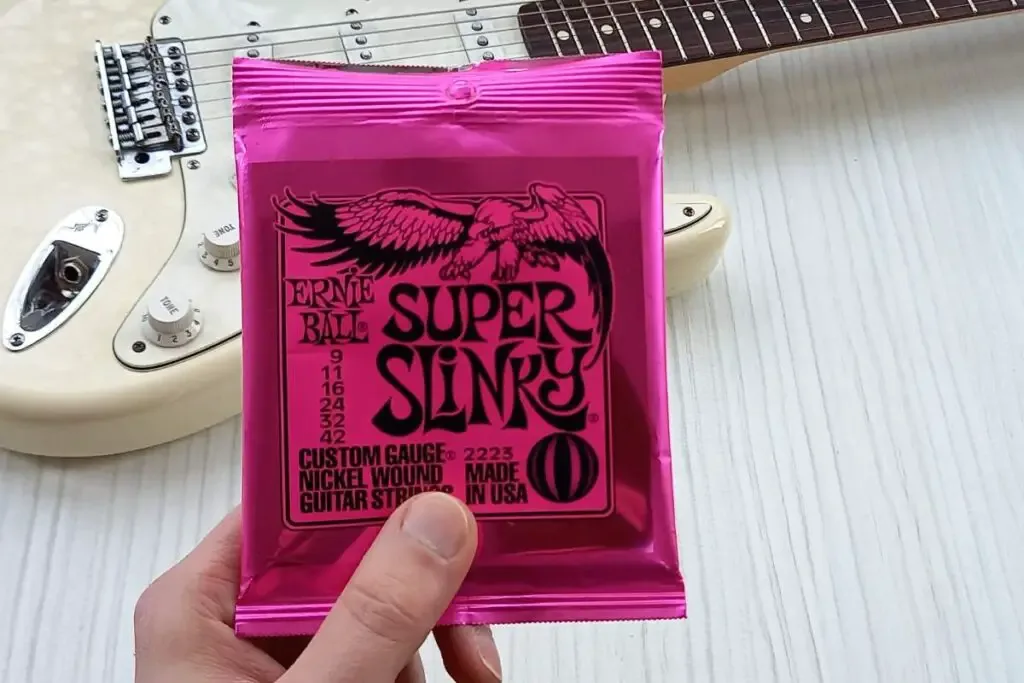
I find that light strings have a bright, treble heavy tone that’s great at cutting through a mix – which I think makes them great for lead guitarists.
That being said, light guitar strings can cause problems like fret buzz if your guitar isn’t set up properly. The lower string tension means that they’re more likely to flop around and rattle against the frets.
Also, if you’re looking to drop tune your guitar, then light strings aren’t for you. Again, the lack of string tension means that they can’t handle drop tuning as effectively as medium or heavy gauge strings.
Thinner guitar strings are also more likely to snap. So, if you’re a heavy handed player, you might find them too weak for your liking!
My experience with light gauge strings
In my opinion, light gauge strings are great for players looking for comfort. The lower string tension means it takes less effort to play compared to medium or heavy gauge strings (which also makes them the perfect string choice for beginners).
The bright, snappy tone lends itself well to blues, rock, pop and country playing.
I use Ernie Ball Super Slinky Strings all the time (gauge 9’s) but when I compared them with the medium and heavy gauge strings I was surprised at just how much more I enjoyed using them in comparison. I was able to play a lot longer without my hands getting tired.
You can check out Ernie Ball Super Slinky strings on Amazon.
But, if you’re looking for a more powerful sound – or to drop tune your guitar – then you’ll need a thicker type of string.
Medium gauge strings
I think of medium strings as being a “best-of-both” solution. Like the porridge from the Goldilocks story: these are a perfect middle ground between light and heavy strings.
Medium strings are more rigid than lighter gauge strings, but they still have plenty of flexibility. Likewise, they have more bass tones than their lighter-gauge counterparts, but there’s still plenty of treble to balance it out. I think that this makes them great for genres like blues and jazz.
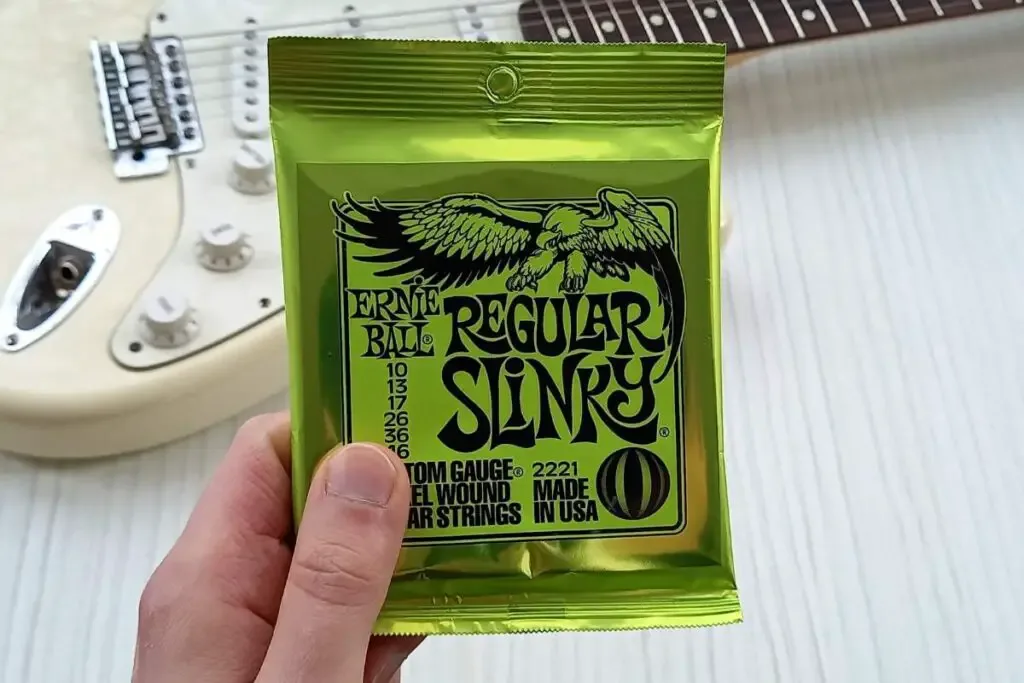
They also have a slightly louder output, which means punchier chords and clearer note articulation – at least in my experience. They’re also less prone to breaking.
As they’re thicker, medium strings put up more resistance when playing, which can tire your hands easier. Still, they’re much easier to use than heavy gauge strings.
The increased string tension also makes them good for drop tuning and standard tuning – so you can change your tuning without having to change your strings! But, you might have some trouble going all the way down to drop A or B.
My experience with medium gauge strings
To me, medium guitar strings are great for any guitarist looking for versatility from their guitar. Their balanced sound, durability, and ability to handle some drop tuning makes them a great workhorse string.
In fact, most guitars in stores come strung up with medium gauge strings (often 10’s) as they’re a great middle ground.
I used the Ernie Ball Regular Slinky strings, which are on the lower side of the medium gauge range, but I could still feel a clear difference between them compared with the lighter strings.
You can check out Ernie Ball Regular Slinky strings on Amazon.
Until very recently, I was a regular user of medium gauge strings. In my experience, I think that they work best for punchy rhythm playing.
I found that they can handle any genre – except super-low tuned metal – but I’ll give a special shout-out to blues or jazz. These strings have a thicker, warmer tone but are still gentle enough not to tire your hands out!
Heavy gauge strings
Heavy strings are known for their dark and powerful sound that’s rich with bass and middle frequencies. When I think of heavy gauge strings, I instantly hear a drop-tuned guitar chugging out a heavy metal riff.
These are the thickest types of guitar string, so they’re much harder to use. Bending and fretting notes takes a lot more effort. Some packs of heavy strings are so thick that they might even come with a wound G string.
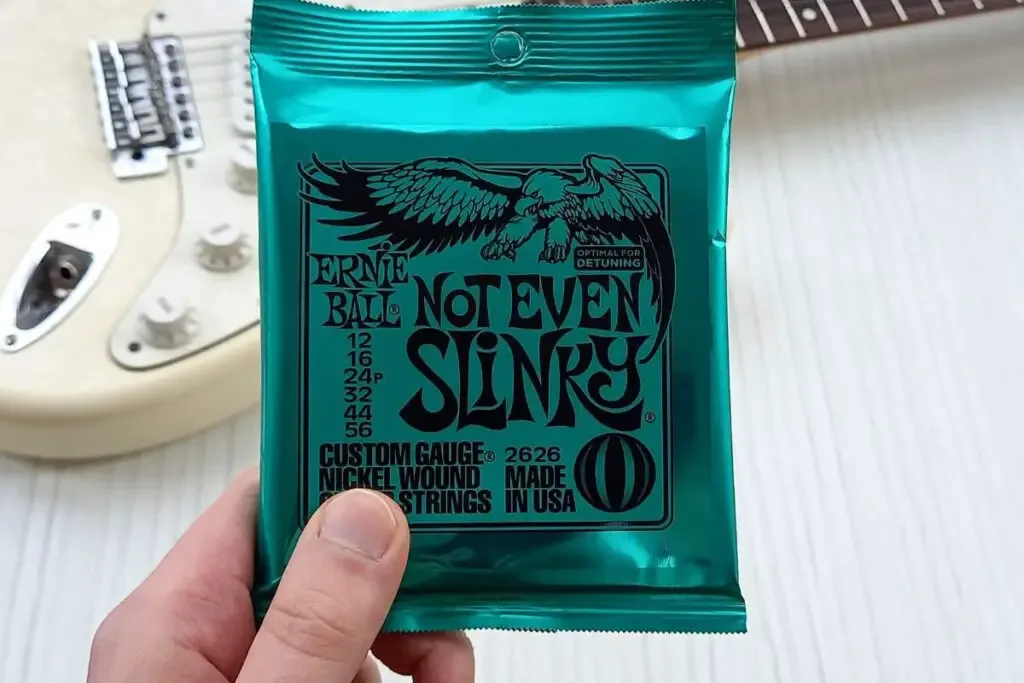
If you’re a beginner, or have smaller hands, then these can be quite challenging to use. But, if you can tolerate the increased difficulty, then the rewards are worth it.
There’s no better string for drop tuning, as they hold their tension at very low tunings (I keep my guitar with heavy strings tuned to drop A!). They also become easier to use at lower tensions – as the strings are more slack – which is an added bonus!
These aren’t just for metal-heads though. Plenty of rock, blues, and jazz musicians use heavy gauge strings for their warmth and power.
Heavy strings are also very durable, being able to withstand even the hardest playing styles. Though, this can mean they put extra wear on your frets!
My experience with heavy gauge strings
In my experience, heavy guitar strings are great for any player looking for a dark, bass-heavy tone or the ability to drop tune their guitar.
My heavy-strings of choice are Ernie Ball’s Not Even Slinky strings. I keep my Les Paul strung up with them at all times, but I also put them on my Stratocaster in the name of fairness to compare them with the light and medium strings.
You can check out Ernie Ball Not Even Slinky strings here on Amazon.
The first thing I noticed was that I needed to adjust my guitar’s set-up to handle these thick strings. The difference between the light and heavy strings was night and day.
Heavy strings have a louder output, which makes them great for rhythm guitar. I do, however, find that they lose some clarity and can sound a bit “muddy”, especially at lower tunings.
If you’re a lead guitarist, then you might have some trouble when it comes to solos. The thicker strings will put up a fight, which – in my experience – makes playing a lot less fun!
But, if you want the heavy sounding bass strings with easier to use top strings, there might be another way… hybrid strings!
Hybrid guitar strings
You might have come across guitar strings listed as “hybrid” strings. These string sets mix unconventional string gauges to give you more customization with the feel and sound of your guitar.
As an example, let’s look at Ernie Ball’s “Skinny Top, Heavy Bottom” strings. As the name suggests, the higher strings are relatively thinner than the bottom strings. In fact, the 3 top strings are the same thickness as the Ernie Ball “Regular Slinky” strings, while the bottom strings are even thicker than the “Not Even Slinky”
In this case, these strings are great for guitarists who want a powerful bottom end but top strings with more flexibility.
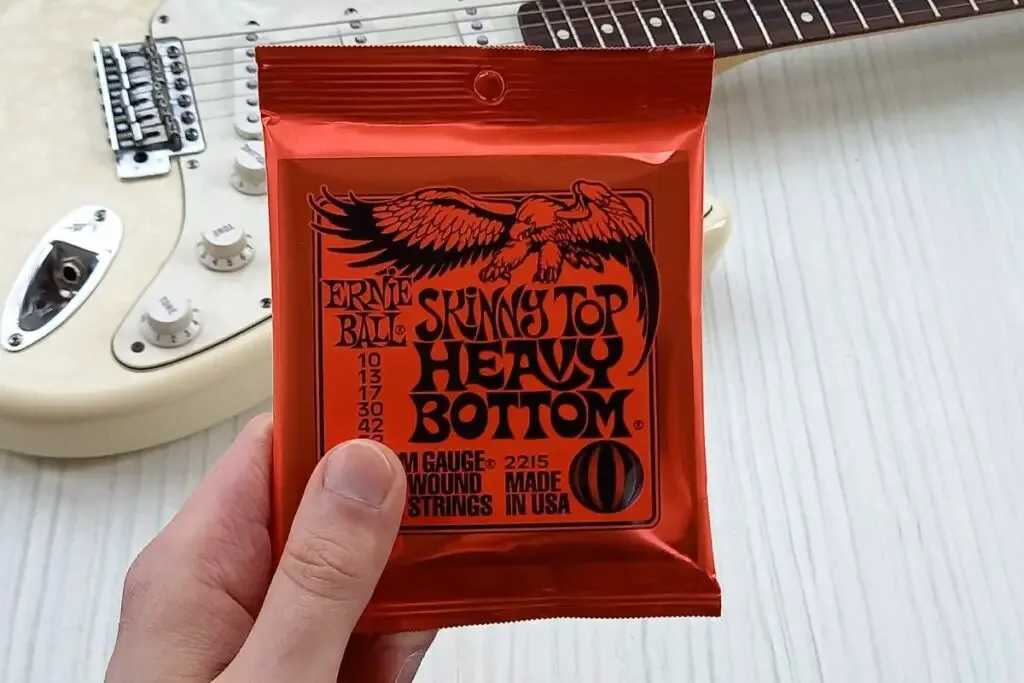
You don’t have to rely on pre-made packs, as you can even take a DIY approach and string up your own custom set. It could sound terrible, but it could also sound great! That’s what I like about hybrid strings – they feel like a fun experiment. Something that’s refreshing and new after years of playing the same types of strings.
But, there are some downsides to hybrid strings. Unlike most packs of strings, the string tension isn’t balanced – meaning the strings have drastically different tensions. This can play havoc with floating bridges, and will likely require you to adjust your guitars set up.
Likewise, they can feel a bit odd. Having such a large difference in string tension and thickness can feel unusual when you move across the different strings.
My experience with hybrid strings
In my opinion, I think hybrid strings work best for rock and metal guitarists. The dark-bass heavy strings give plenty of power and grit, but the lighter gauge higher strings are easier to use when it comes to soloing.
They felt a bit strange to use, but I got used to them after a while, and I can see why people would use them. It really felt like I was getting the best of lighter and heavier string gauges.
I used the Ernie Ball Skinny Top Heavy Bottom strings. You can check them out here on Amazon.
Final thoughts
Light, medium, and heavy strings are a great way to change the way your guitar feels and sounds.
- If you’re looking for something easy to play with a bright sound then check out light strings.
- For a more balanced sound, with slightly more power, then try medium strings.
- Heavy strings will give you the most powerful sound, with handfuls of dark tones – but they’re much harder to use.
- Hybrid strings give the flexibility of light strings with the dark bass of heavy strings. But, they can feel odd to use.
I’m lucky enough to have a few different guitars, so I keep a range of strings on all of them. Personally, I’m a big fan of light strings at the moment because they’re so easy to use! But, when I’m drop tuning, I go straight to my heavy strings.
At the end of the day, I recommend trying out as many different types of strings as you can until you find the ones that work for you!

Conor is a music producer, multi-instrumentalist, and all-round enthusiast from the UK with over 15 years of experience. He’s the founder and sole-content creator for the roundtable audio blog and YouTube channel.
